Evaluation of the Seven Principles of Supply Chain Management
VerifiedAdded on 2023/04/19
|8
|3511
|75
Report
AI Summary
This report analyzes the article "The Seven Principles of Supply Chain Management," exploring its purpose, arguments, and implications for modern business. The assignment examines the authors' intent to outline a framework for supply chain excellence, focusing on customer segmentation, network modification, demand anticipation, product differentiation, outsourcing strategies, technology integration, and financial metrics. It critiques the methodology, comparing it to contemporary SCM practices and examining the author's line of reasoning, assumptions, and the usefulness of the article for both theory and practice. The report also discusses the importance of balancing customer satisfaction and profitability, highlighting the need for a holistic and coordinated approach to supply chain management to achieve competitive advantages. The report evaluates the seven principles, their relevance, and the author's recommendations, emphasizing the need for consistent efforts and strategic implementation.
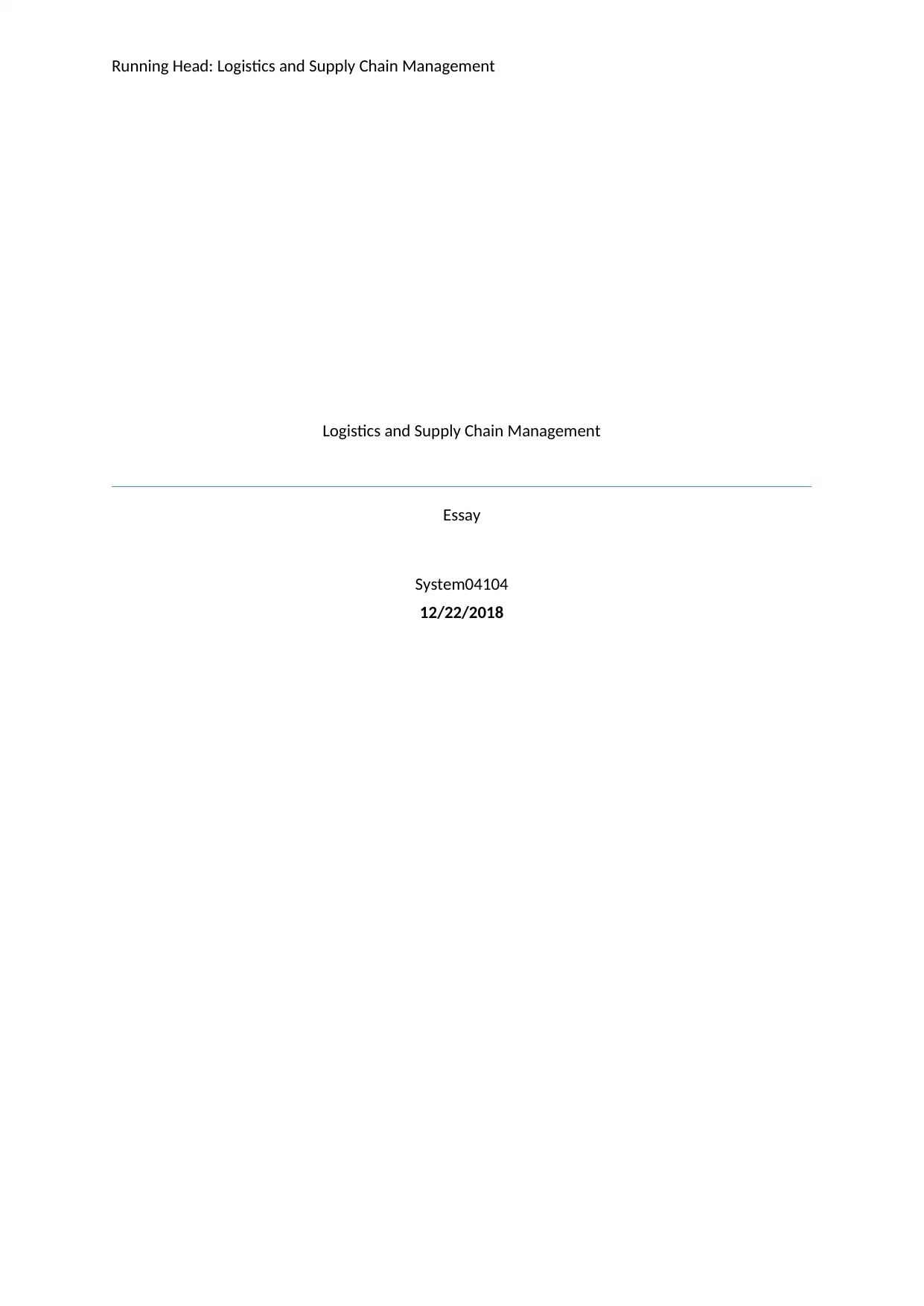
Running Head: Logistics and Supply Chain Management
Logistics and Supply Chain Management
Essay
System04104
12/22/2018
Logistics and Supply Chain Management
Essay
System04104
12/22/2018
Paraphrase This Document
Need a fresh take? Get an instant paraphrase of this document with our AI Paraphraser
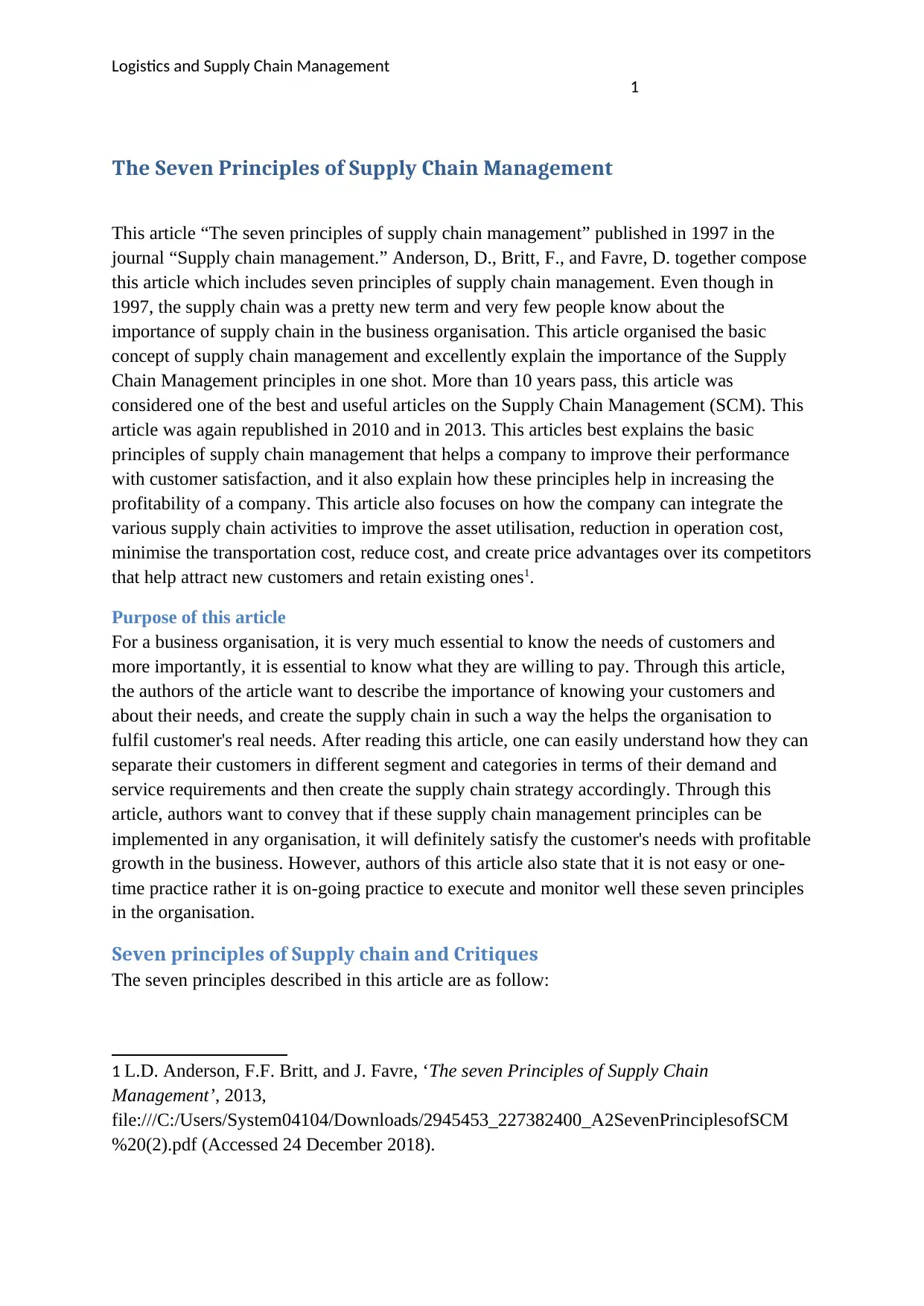
Logistics and Supply Chain Management
1
The Seven Principles of Supply Chain Management
This article “The seven principles of supply chain management” published in 1997 in the
journal “Supply chain management.” Anderson, D., Britt, F., and Favre, D. together compose
this article which includes seven principles of supply chain management. Even though in
1997, the supply chain was a pretty new term and very few people know about the
importance of supply chain in the business organisation. This article organised the basic
concept of supply chain management and excellently explain the importance of the Supply
Chain Management principles in one shot. More than 10 years pass, this article was
considered one of the best and useful articles on the Supply Chain Management (SCM). This
article was again republished in 2010 and in 2013. This articles best explains the basic
principles of supply chain management that helps a company to improve their performance
with customer satisfaction, and it also explain how these principles help in increasing the
profitability of a company. This article also focuses on how the company can integrate the
various supply chain activities to improve the asset utilisation, reduction in operation cost,
minimise the transportation cost, reduce cost, and create price advantages over its competitors
that help attract new customers and retain existing ones1.
Purpose of this article
For a business organisation, it is very much essential to know the needs of customers and
more importantly, it is essential to know what they are willing to pay. Through this article,
the authors of the article want to describe the importance of knowing your customers and
about their needs, and create the supply chain in such a way the helps the organisation to
fulfil customer's real needs. After reading this article, one can easily understand how they can
separate their customers in different segment and categories in terms of their demand and
service requirements and then create the supply chain strategy accordingly. Through this
article, authors want to convey that if these supply chain management principles can be
implemented in any organisation, it will definitely satisfy the customer's needs with profitable
growth in the business. However, authors of this article also state that it is not easy or one-
time practice rather it is on-going practice to execute and monitor well these seven principles
in the organisation.
Seven principles of Supply chain and Critiques
The seven principles described in this article are as follow:
1 L.D. Anderson, F.F. Britt, and J. Favre, ‘The seven Principles of Supply Chain
Management’, 2013,
file:///C:/Users/System04104/Downloads/2945453_227382400_A2SevenPrinciplesofSCM
%20(2).pdf (Accessed 24 December 2018).
1
The Seven Principles of Supply Chain Management
This article “The seven principles of supply chain management” published in 1997 in the
journal “Supply chain management.” Anderson, D., Britt, F., and Favre, D. together compose
this article which includes seven principles of supply chain management. Even though in
1997, the supply chain was a pretty new term and very few people know about the
importance of supply chain in the business organisation. This article organised the basic
concept of supply chain management and excellently explain the importance of the Supply
Chain Management principles in one shot. More than 10 years pass, this article was
considered one of the best and useful articles on the Supply Chain Management (SCM). This
article was again republished in 2010 and in 2013. This articles best explains the basic
principles of supply chain management that helps a company to improve their performance
with customer satisfaction, and it also explain how these principles help in increasing the
profitability of a company. This article also focuses on how the company can integrate the
various supply chain activities to improve the asset utilisation, reduction in operation cost,
minimise the transportation cost, reduce cost, and create price advantages over its competitors
that help attract new customers and retain existing ones1.
Purpose of this article
For a business organisation, it is very much essential to know the needs of customers and
more importantly, it is essential to know what they are willing to pay. Through this article,
the authors of the article want to describe the importance of knowing your customers and
about their needs, and create the supply chain in such a way the helps the organisation to
fulfil customer's real needs. After reading this article, one can easily understand how they can
separate their customers in different segment and categories in terms of their demand and
service requirements and then create the supply chain strategy accordingly. Through this
article, authors want to convey that if these supply chain management principles can be
implemented in any organisation, it will definitely satisfy the customer's needs with profitable
growth in the business. However, authors of this article also state that it is not easy or one-
time practice rather it is on-going practice to execute and monitor well these seven principles
in the organisation.
Seven principles of Supply chain and Critiques
The seven principles described in this article are as follow:
1 L.D. Anderson, F.F. Britt, and J. Favre, ‘The seven Principles of Supply Chain
Management’, 2013,
file:///C:/Users/System04104/Downloads/2945453_227382400_A2SevenPrinciplesofSCM
%20(2).pdf (Accessed 24 December 2018).
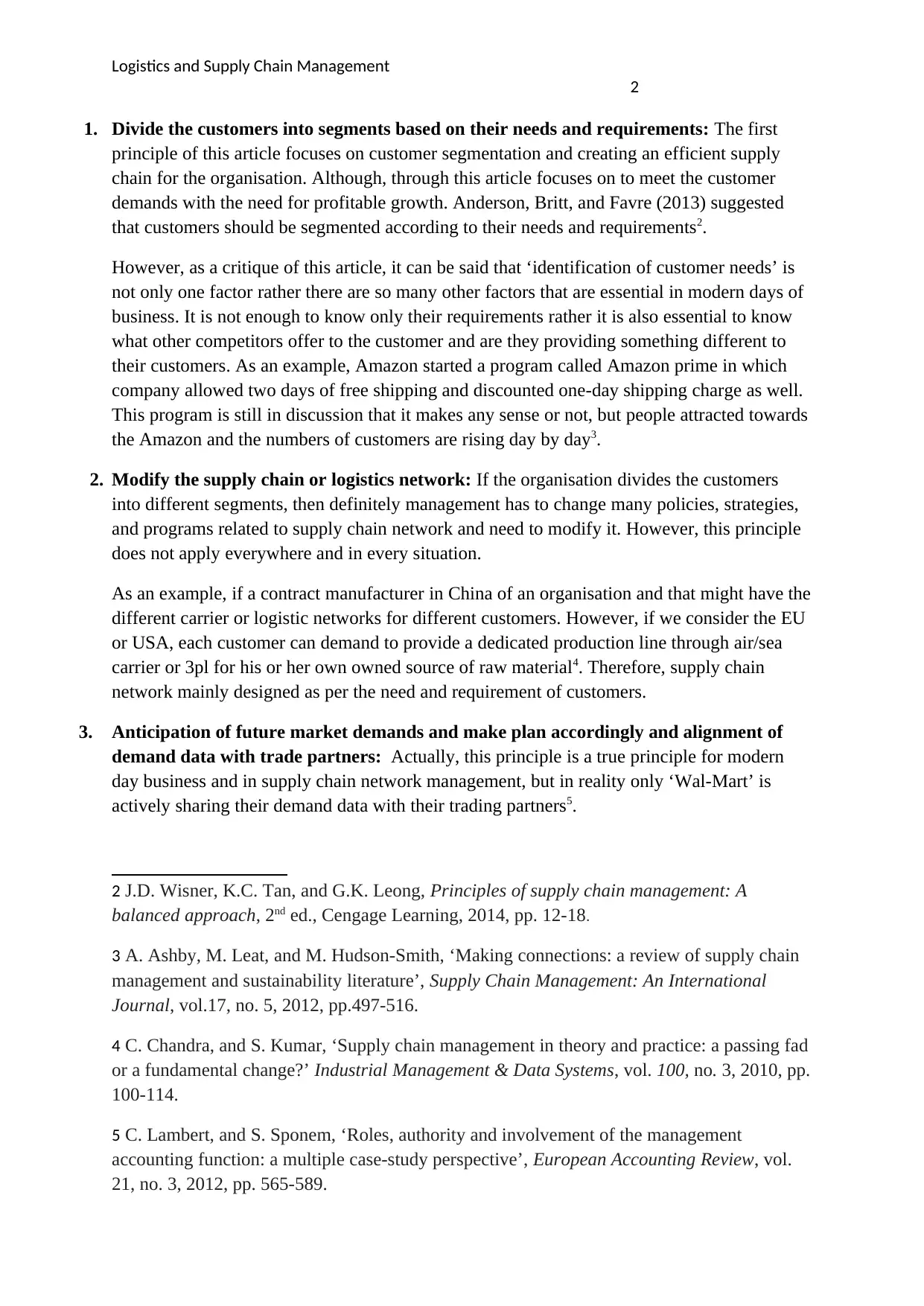
Logistics and Supply Chain Management
2
1. Divide the customers into segments based on their needs and requirements: The first
principle of this article focuses on customer segmentation and creating an efficient supply
chain for the organisation. Although, through this article focuses on to meet the customer
demands with the need for profitable growth. Anderson, Britt, and Favre (2013) suggested
that customers should be segmented according to their needs and requirements2.
However, as a critique of this article, it can be said that ‘identification of customer needs’ is
not only one factor rather there are so many other factors that are essential in modern days of
business. It is not enough to know only their requirements rather it is also essential to know
what other competitors offer to the customer and are they providing something different to
their customers. As an example, Amazon started a program called Amazon prime in which
company allowed two days of free shipping and discounted one-day shipping charge as well.
This program is still in discussion that it makes any sense or not, but people attracted towards
the Amazon and the numbers of customers are rising day by day3.
2. Modify the supply chain or logistics network: If the organisation divides the customers
into different segments, then definitely management has to change many policies, strategies,
and programs related to supply chain network and need to modify it. However, this principle
does not apply everywhere and in every situation.
As an example, if a contract manufacturer in China of an organisation and that might have the
different carrier or logistic networks for different customers. However, if we consider the EU
or USA, each customer can demand to provide a dedicated production line through air/sea
carrier or 3pl for his or her own owned source of raw material4. Therefore, supply chain
network mainly designed as per the need and requirement of customers.
3. Anticipation of future market demands and make plan accordingly and alignment of
demand data with trade partners: Actually, this principle is a true principle for modern
day business and in supply chain network management, but in reality only ‘Wal-Mart’ is
actively sharing their demand data with their trading partners5.
2 J.D. Wisner, K.C. Tan, and G.K. Leong, Principles of supply chain management: A
balanced approach, 2nd ed., Cengage Learning, 2014, pp. 12-18.
3 A. Ashby, M. Leat, and M. Hudson-Smith, ‘Making connections: a review of supply chain
management and sustainability literature’, Supply Chain Management: An International
Journal, vol.17, no. 5, 2012, pp.497-516.
4 C. Chandra, and S. Kumar, ‘Supply chain management in theory and practice: a passing fad
or a fundamental change?’ Industrial Management & Data Systems, vol. 100, no. 3, 2010, pp.
100-114.
5 C. Lambert, and S. Sponem, ‘Roles, authority and involvement of the management
accounting function: a multiple case-study perspective’, European Accounting Review, vol.
21, no. 3, 2012, pp. 565-589.
2
1. Divide the customers into segments based on their needs and requirements: The first
principle of this article focuses on customer segmentation and creating an efficient supply
chain for the organisation. Although, through this article focuses on to meet the customer
demands with the need for profitable growth. Anderson, Britt, and Favre (2013) suggested
that customers should be segmented according to their needs and requirements2.
However, as a critique of this article, it can be said that ‘identification of customer needs’ is
not only one factor rather there are so many other factors that are essential in modern days of
business. It is not enough to know only their requirements rather it is also essential to know
what other competitors offer to the customer and are they providing something different to
their customers. As an example, Amazon started a program called Amazon prime in which
company allowed two days of free shipping and discounted one-day shipping charge as well.
This program is still in discussion that it makes any sense or not, but people attracted towards
the Amazon and the numbers of customers are rising day by day3.
2. Modify the supply chain or logistics network: If the organisation divides the customers
into different segments, then definitely management has to change many policies, strategies,
and programs related to supply chain network and need to modify it. However, this principle
does not apply everywhere and in every situation.
As an example, if a contract manufacturer in China of an organisation and that might have the
different carrier or logistic networks for different customers. However, if we consider the EU
or USA, each customer can demand to provide a dedicated production line through air/sea
carrier or 3pl for his or her own owned source of raw material4. Therefore, supply chain
network mainly designed as per the need and requirement of customers.
3. Anticipation of future market demands and make plan accordingly and alignment of
demand data with trade partners: Actually, this principle is a true principle for modern
day business and in supply chain network management, but in reality only ‘Wal-Mart’ is
actively sharing their demand data with their trading partners5.
2 J.D. Wisner, K.C. Tan, and G.K. Leong, Principles of supply chain management: A
balanced approach, 2nd ed., Cengage Learning, 2014, pp. 12-18.
3 A. Ashby, M. Leat, and M. Hudson-Smith, ‘Making connections: a review of supply chain
management and sustainability literature’, Supply Chain Management: An International
Journal, vol.17, no. 5, 2012, pp.497-516.
4 C. Chandra, and S. Kumar, ‘Supply chain management in theory and practice: a passing fad
or a fundamental change?’ Industrial Management & Data Systems, vol. 100, no. 3, 2010, pp.
100-114.
5 C. Lambert, and S. Sponem, ‘Roles, authority and involvement of the management
accounting function: a multiple case-study perspective’, European Accounting Review, vol.
21, no. 3, 2012, pp. 565-589.
⊘ This is a preview!⊘
Do you want full access?
Subscribe today to unlock all pages.

Trusted by 1+ million students worldwide
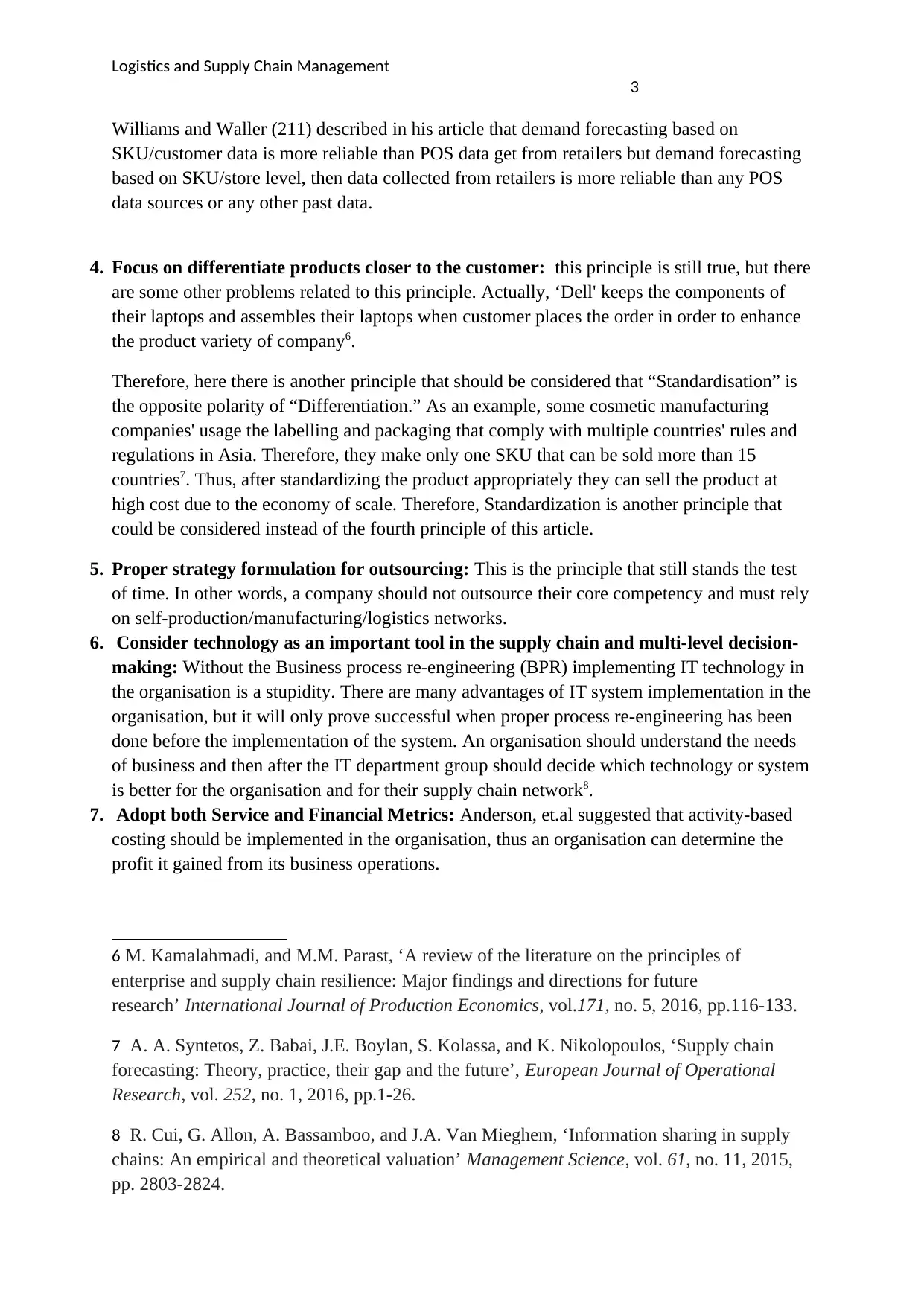
Logistics and Supply Chain Management
3
Williams and Waller (211) described in his article that demand forecasting based on
SKU/customer data is more reliable than POS data get from retailers but demand forecasting
based on SKU/store level, then data collected from retailers is more reliable than any POS
data sources or any other past data.
4. Focus on differentiate products closer to the customer: this principle is still true, but there
are some other problems related to this principle. Actually, ‘Dell' keeps the components of
their laptops and assembles their laptops when customer places the order in order to enhance
the product variety of company6.
Therefore, here there is another principle that should be considered that “Standardisation” is
the opposite polarity of “Differentiation.” As an example, some cosmetic manufacturing
companies' usage the labelling and packaging that comply with multiple countries' rules and
regulations in Asia. Therefore, they make only one SKU that can be sold more than 15
countries7. Thus, after standardizing the product appropriately they can sell the product at
high cost due to the economy of scale. Therefore, Standardization is another principle that
could be considered instead of the fourth principle of this article.
5. Proper strategy formulation for outsourcing: This is the principle that still stands the test
of time. In other words, a company should not outsource their core competency and must rely
on self-production/manufacturing/logistics networks.
6. Consider technology as an important tool in the supply chain and multi-level decision-
making: Without the Business process re-engineering (BPR) implementing IT technology in
the organisation is a stupidity. There are many advantages of IT system implementation in the
organisation, but it will only prove successful when proper process re-engineering has been
done before the implementation of the system. An organisation should understand the needs
of business and then after the IT department group should decide which technology or system
is better for the organisation and for their supply chain network8.
7. Adopt both Service and Financial Metrics: Anderson, et.al suggested that activity-based
costing should be implemented in the organisation, thus an organisation can determine the
profit it gained from its business operations.
6 M. Kamalahmadi, and M.M. Parast, ‘A review of the literature on the principles of
enterprise and supply chain resilience: Major findings and directions for future
research’ International Journal of Production Economics, vol.171, no. 5, 2016, pp.116-133.
7 A. A. Syntetos, Z. Babai, J.E. Boylan, S. Kolassa, and K. Nikolopoulos, ‘Supply chain
forecasting: Theory, practice, their gap and the future’, European Journal of Operational
Research, vol. 252, no. 1, 2016, pp.1-26.
8 R. Cui, G. Allon, A. Bassamboo, and J.A. Van Mieghem, ‘Information sharing in supply
chains: An empirical and theoretical valuation’ Management Science, vol. 61, no. 11, 2015,
pp. 2803-2824.
3
Williams and Waller (211) described in his article that demand forecasting based on
SKU/customer data is more reliable than POS data get from retailers but demand forecasting
based on SKU/store level, then data collected from retailers is more reliable than any POS
data sources or any other past data.
4. Focus on differentiate products closer to the customer: this principle is still true, but there
are some other problems related to this principle. Actually, ‘Dell' keeps the components of
their laptops and assembles their laptops when customer places the order in order to enhance
the product variety of company6.
Therefore, here there is another principle that should be considered that “Standardisation” is
the opposite polarity of “Differentiation.” As an example, some cosmetic manufacturing
companies' usage the labelling and packaging that comply with multiple countries' rules and
regulations in Asia. Therefore, they make only one SKU that can be sold more than 15
countries7. Thus, after standardizing the product appropriately they can sell the product at
high cost due to the economy of scale. Therefore, Standardization is another principle that
could be considered instead of the fourth principle of this article.
5. Proper strategy formulation for outsourcing: This is the principle that still stands the test
of time. In other words, a company should not outsource their core competency and must rely
on self-production/manufacturing/logistics networks.
6. Consider technology as an important tool in the supply chain and multi-level decision-
making: Without the Business process re-engineering (BPR) implementing IT technology in
the organisation is a stupidity. There are many advantages of IT system implementation in the
organisation, but it will only prove successful when proper process re-engineering has been
done before the implementation of the system. An organisation should understand the needs
of business and then after the IT department group should decide which technology or system
is better for the organisation and for their supply chain network8.
7. Adopt both Service and Financial Metrics: Anderson, et.al suggested that activity-based
costing should be implemented in the organisation, thus an organisation can determine the
profit it gained from its business operations.
6 M. Kamalahmadi, and M.M. Parast, ‘A review of the literature on the principles of
enterprise and supply chain resilience: Major findings and directions for future
research’ International Journal of Production Economics, vol.171, no. 5, 2016, pp.116-133.
7 A. A. Syntetos, Z. Babai, J.E. Boylan, S. Kolassa, and K. Nikolopoulos, ‘Supply chain
forecasting: Theory, practice, their gap and the future’, European Journal of Operational
Research, vol. 252, no. 1, 2016, pp.1-26.
8 R. Cui, G. Allon, A. Bassamboo, and J.A. Van Mieghem, ‘Information sharing in supply
chains: An empirical and theoretical valuation’ Management Science, vol. 61, no. 11, 2015,
pp. 2803-2824.
Paraphrase This Document
Need a fresh take? Get an instant paraphrase of this document with our AI Paraphraser
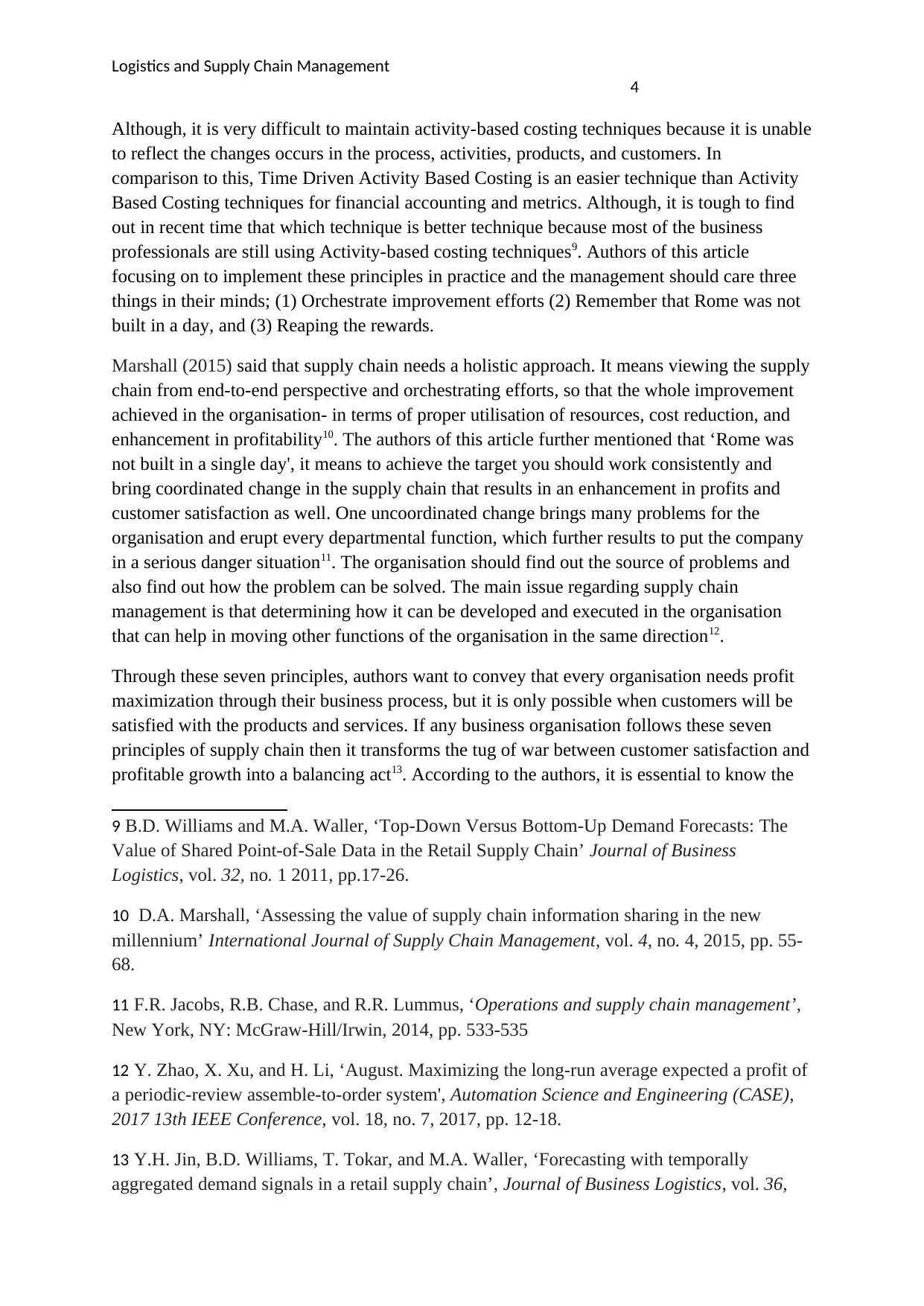
Logistics and Supply Chain Management
4
Although, it is very difficult to maintain activity-based costing techniques because it is unable
to reflect the changes occurs in the process, activities, products, and customers. In
comparison to this, Time Driven Activity Based Costing is an easier technique than Activity
Based Costing techniques for financial accounting and metrics. Although, it is tough to find
out in recent time that which technique is better technique because most of the business
professionals are still using Activity-based costing techniques9. Authors of this article
focusing on to implement these principles in practice and the management should care three
things in their minds; (1) Orchestrate improvement efforts (2) Remember that Rome was not
built in a day, and (3) Reaping the rewards.
Marshall (2015) said that supply chain needs a holistic approach. It means viewing the supply
chain from end-to-end perspective and orchestrating efforts, so that the whole improvement
achieved in the organisation- in terms of proper utilisation of resources, cost reduction, and
enhancement in profitability10. The authors of this article further mentioned that ‘Rome was
not built in a single day', it means to achieve the target you should work consistently and
bring coordinated change in the supply chain that results in an enhancement in profits and
customer satisfaction as well. One uncoordinated change brings many problems for the
organisation and erupt every departmental function, which further results to put the company
in a serious danger situation11. The organisation should find out the source of problems and
also find out how the problem can be solved. The main issue regarding supply chain
management is that determining how it can be developed and executed in the organisation
that can help in moving other functions of the organisation in the same direction12.
Through these seven principles, authors want to convey that every organisation needs profit
maximization through their business process, but it is only possible when customers will be
satisfied with the products and services. If any business organisation follows these seven
principles of supply chain then it transforms the tug of war between customer satisfaction and
profitable growth into a balancing act13. According to the authors, it is essential to know the
9 B.D. Williams and M.A. Waller, ‘Top‐Down Versus Bottom‐Up Demand Forecasts: The
Value of Shared Point‐of‐Sale Data in the Retail Supply Chain’ Journal of Business
Logistics, vol. 32, no. 1 2011, pp.17-26.
10 D.A. Marshall, ‘Assessing the value of supply chain information sharing in the new
millennium’ International Journal of Supply Chain Management, vol. 4, no. 4, 2015, pp. 55-
68.
11 F.R. Jacobs, R.B. Chase, and R.R. Lummus, ‘Operations and supply chain management’,
New York, NY: McGraw-Hill/Irwin, 2014, pp. 533-535
12 Y. Zhao, X. Xu, and H. Li, ‘August. Maximizing the long-run average expected a profit of
a periodic-review assemble-to-order system', Automation Science and Engineering (CASE),
2017 13th IEEE Conference, vol. 18, no. 7, 2017, pp. 12-18.
13 Y.H. Jin, B.D. Williams, T. Tokar, and M.A. Waller, ‘Forecasting with temporally
aggregated demand signals in a retail supply chain’, Journal of Business Logistics, vol. 36,
4
Although, it is very difficult to maintain activity-based costing techniques because it is unable
to reflect the changes occurs in the process, activities, products, and customers. In
comparison to this, Time Driven Activity Based Costing is an easier technique than Activity
Based Costing techniques for financial accounting and metrics. Although, it is tough to find
out in recent time that which technique is better technique because most of the business
professionals are still using Activity-based costing techniques9. Authors of this article
focusing on to implement these principles in practice and the management should care three
things in their minds; (1) Orchestrate improvement efforts (2) Remember that Rome was not
built in a day, and (3) Reaping the rewards.
Marshall (2015) said that supply chain needs a holistic approach. It means viewing the supply
chain from end-to-end perspective and orchestrating efforts, so that the whole improvement
achieved in the organisation- in terms of proper utilisation of resources, cost reduction, and
enhancement in profitability10. The authors of this article further mentioned that ‘Rome was
not built in a single day', it means to achieve the target you should work consistently and
bring coordinated change in the supply chain that results in an enhancement in profits and
customer satisfaction as well. One uncoordinated change brings many problems for the
organisation and erupt every departmental function, which further results to put the company
in a serious danger situation11. The organisation should find out the source of problems and
also find out how the problem can be solved. The main issue regarding supply chain
management is that determining how it can be developed and executed in the organisation
that can help in moving other functions of the organisation in the same direction12.
Through these seven principles, authors want to convey that every organisation needs profit
maximization through their business process, but it is only possible when customers will be
satisfied with the products and services. If any business organisation follows these seven
principles of supply chain then it transforms the tug of war between customer satisfaction and
profitable growth into a balancing act13. According to the authors, it is essential to know the
9 B.D. Williams and M.A. Waller, ‘Top‐Down Versus Bottom‐Up Demand Forecasts: The
Value of Shared Point‐of‐Sale Data in the Retail Supply Chain’ Journal of Business
Logistics, vol. 32, no. 1 2011, pp.17-26.
10 D.A. Marshall, ‘Assessing the value of supply chain information sharing in the new
millennium’ International Journal of Supply Chain Management, vol. 4, no. 4, 2015, pp. 55-
68.
11 F.R. Jacobs, R.B. Chase, and R.R. Lummus, ‘Operations and supply chain management’,
New York, NY: McGraw-Hill/Irwin, 2014, pp. 533-535
12 Y. Zhao, X. Xu, and H. Li, ‘August. Maximizing the long-run average expected a profit of
a periodic-review assemble-to-order system', Automation Science and Engineering (CASE),
2017 13th IEEE Conference, vol. 18, no. 7, 2017, pp. 12-18.
13 Y.H. Jin, B.D. Williams, T. Tokar, and M.A. Waller, ‘Forecasting with temporally
aggregated demand signals in a retail supply chain’, Journal of Business Logistics, vol. 36,
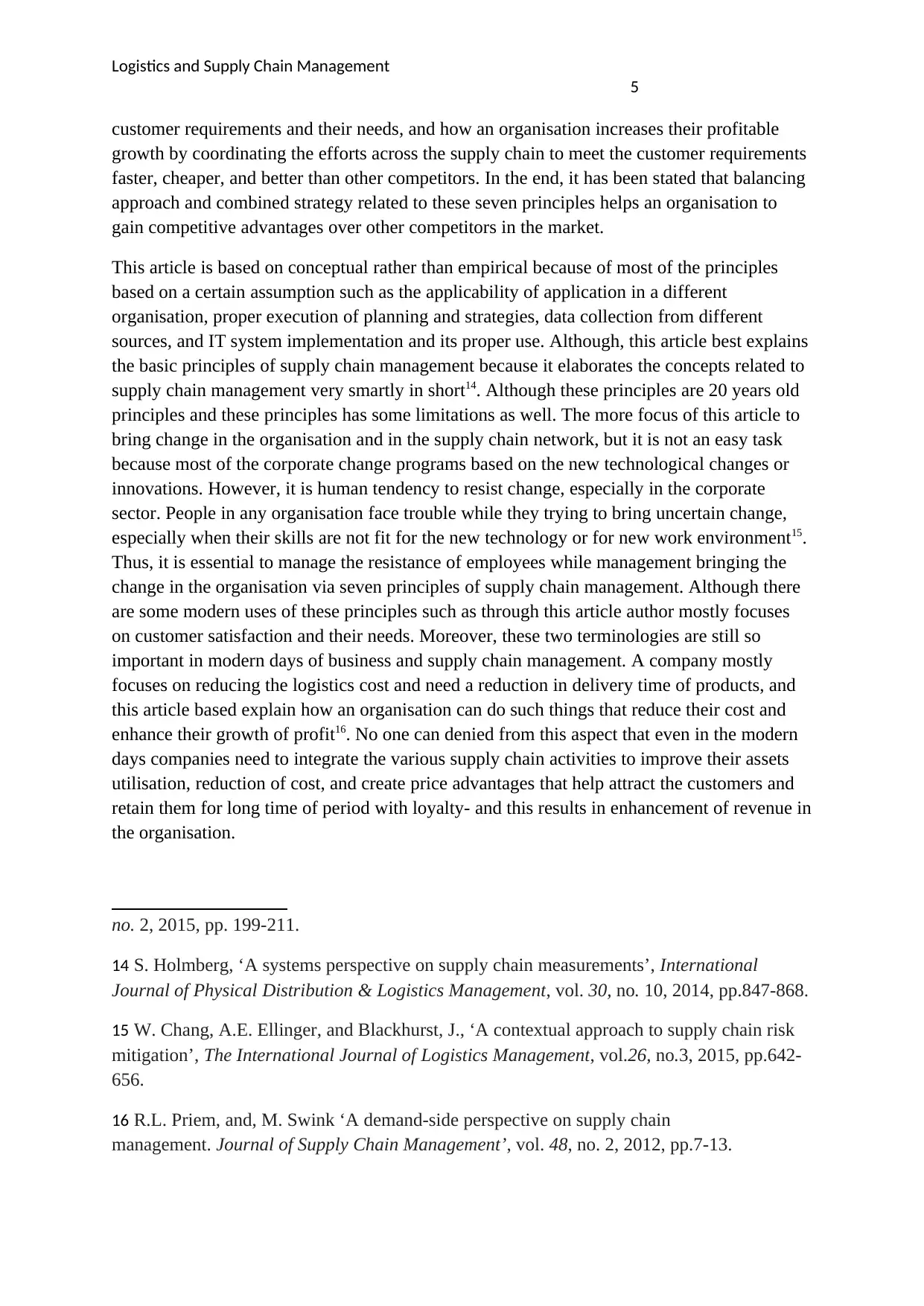
Logistics and Supply Chain Management
5
customer requirements and their needs, and how an organisation increases their profitable
growth by coordinating the efforts across the supply chain to meet the customer requirements
faster, cheaper, and better than other competitors. In the end, it has been stated that balancing
approach and combined strategy related to these seven principles helps an organisation to
gain competitive advantages over other competitors in the market.
This article is based on conceptual rather than empirical because of most of the principles
based on a certain assumption such as the applicability of application in a different
organisation, proper execution of planning and strategies, data collection from different
sources, and IT system implementation and its proper use. Although, this article best explains
the basic principles of supply chain management because it elaborates the concepts related to
supply chain management very smartly in short14. Although these principles are 20 years old
principles and these principles has some limitations as well. The more focus of this article to
bring change in the organisation and in the supply chain network, but it is not an easy task
because most of the corporate change programs based on the new technological changes or
innovations. However, it is human tendency to resist change, especially in the corporate
sector. People in any organisation face trouble while they trying to bring uncertain change,
especially when their skills are not fit for the new technology or for new work environment15.
Thus, it is essential to manage the resistance of employees while management bringing the
change in the organisation via seven principles of supply chain management. Although there
are some modern uses of these principles such as through this article author mostly focuses
on customer satisfaction and their needs. Moreover, these two terminologies are still so
important in modern days of business and supply chain management. A company mostly
focuses on reducing the logistics cost and need a reduction in delivery time of products, and
this article based explain how an organisation can do such things that reduce their cost and
enhance their growth of profit16. No one can denied from this aspect that even in the modern
days companies need to integrate the various supply chain activities to improve their assets
utilisation, reduction of cost, and create price advantages that help attract the customers and
retain them for long time of period with loyalty- and this results in enhancement of revenue in
the organisation.
no. 2, 2015, pp. 199-211.
14 S. Holmberg, ‘A systems perspective on supply chain measurements’, International
Journal of Physical Distribution & Logistics Management, vol. 30, no. 10, 2014, pp.847-868.
15 W. Chang, A.E. Ellinger, and Blackhurst, J., ‘A contextual approach to supply chain risk
mitigation’, The International Journal of Logistics Management, vol.26, no.3, 2015, pp.642-
656.
16 R.L. Priem, and, M. Swink ‘A demand‐side perspective on supply chain
management. Journal of Supply Chain Management’, vol. 48, no. 2, 2012, pp.7-13.
5
customer requirements and their needs, and how an organisation increases their profitable
growth by coordinating the efforts across the supply chain to meet the customer requirements
faster, cheaper, and better than other competitors. In the end, it has been stated that balancing
approach and combined strategy related to these seven principles helps an organisation to
gain competitive advantages over other competitors in the market.
This article is based on conceptual rather than empirical because of most of the principles
based on a certain assumption such as the applicability of application in a different
organisation, proper execution of planning and strategies, data collection from different
sources, and IT system implementation and its proper use. Although, this article best explains
the basic principles of supply chain management because it elaborates the concepts related to
supply chain management very smartly in short14. Although these principles are 20 years old
principles and these principles has some limitations as well. The more focus of this article to
bring change in the organisation and in the supply chain network, but it is not an easy task
because most of the corporate change programs based on the new technological changes or
innovations. However, it is human tendency to resist change, especially in the corporate
sector. People in any organisation face trouble while they trying to bring uncertain change,
especially when their skills are not fit for the new technology or for new work environment15.
Thus, it is essential to manage the resistance of employees while management bringing the
change in the organisation via seven principles of supply chain management. Although there
are some modern uses of these principles such as through this article author mostly focuses
on customer satisfaction and their needs. Moreover, these two terminologies are still so
important in modern days of business and supply chain management. A company mostly
focuses on reducing the logistics cost and need a reduction in delivery time of products, and
this article based explain how an organisation can do such things that reduce their cost and
enhance their growth of profit16. No one can denied from this aspect that even in the modern
days companies need to integrate the various supply chain activities to improve their assets
utilisation, reduction of cost, and create price advantages that help attract the customers and
retain them for long time of period with loyalty- and this results in enhancement of revenue in
the organisation.
no. 2, 2015, pp. 199-211.
14 S. Holmberg, ‘A systems perspective on supply chain measurements’, International
Journal of Physical Distribution & Logistics Management, vol. 30, no. 10, 2014, pp.847-868.
15 W. Chang, A.E. Ellinger, and Blackhurst, J., ‘A contextual approach to supply chain risk
mitigation’, The International Journal of Logistics Management, vol.26, no.3, 2015, pp.642-
656.
16 R.L. Priem, and, M. Swink ‘A demand‐side perspective on supply chain
management. Journal of Supply Chain Management’, vol. 48, no. 2, 2012, pp.7-13.
⊘ This is a preview!⊘
Do you want full access?
Subscribe today to unlock all pages.

Trusted by 1+ million students worldwide
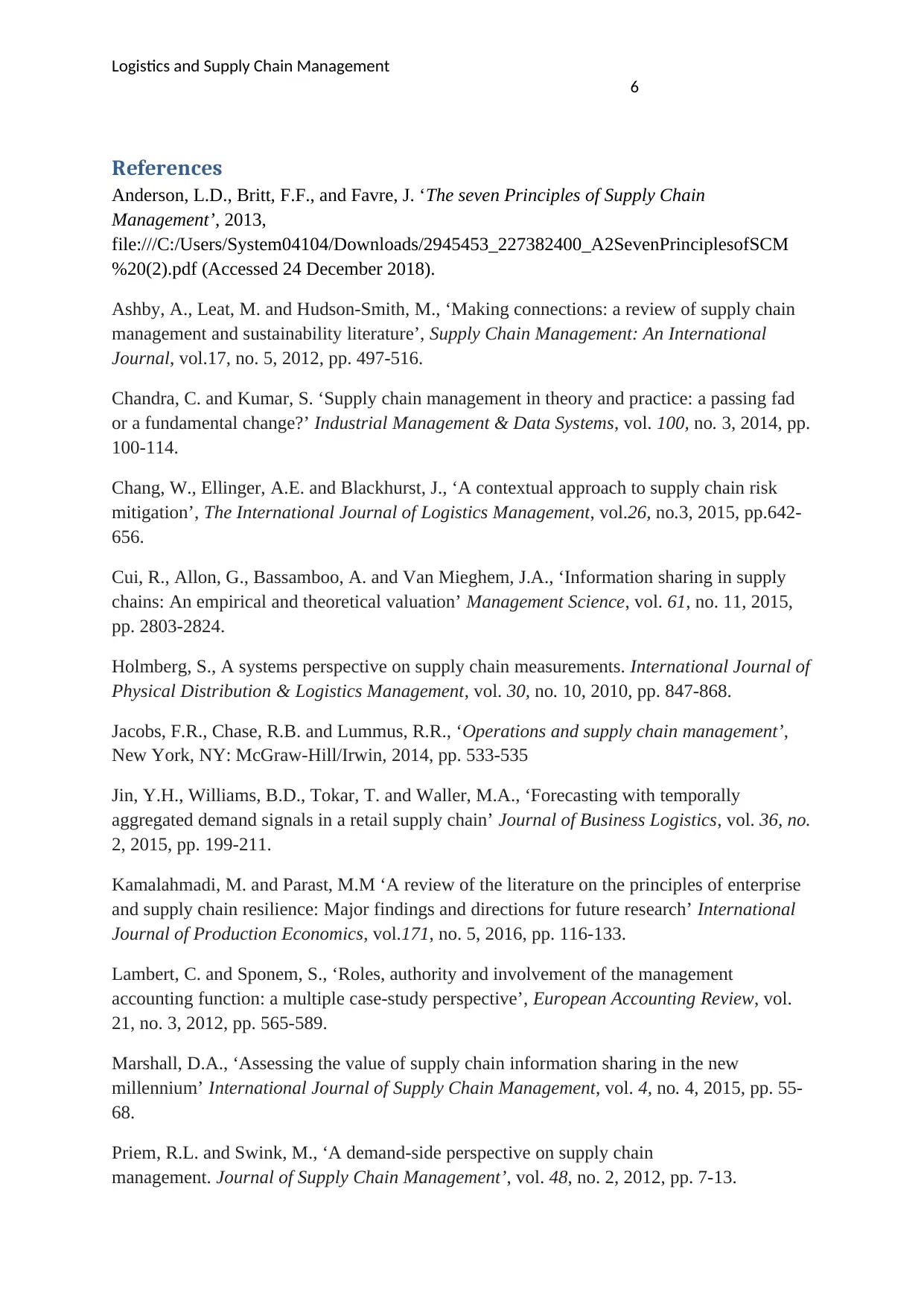
Logistics and Supply Chain Management
6
References
Anderson, L.D., Britt, F.F., and Favre, J. ‘The seven Principles of Supply Chain
Management’, 2013,
file:///C:/Users/System04104/Downloads/2945453_227382400_A2SevenPrinciplesofSCM
%20(2).pdf (Accessed 24 December 2018).
Ashby, A., Leat, M. and Hudson-Smith, M., ‘Making connections: a review of supply chain
management and sustainability literature’, Supply Chain Management: An International
Journal, vol.17, no. 5, 2012, pp. 497-516.
Chandra, C. and Kumar, S. ‘Supply chain management in theory and practice: a passing fad
or a fundamental change?’ Industrial Management & Data Systems, vol. 100, no. 3, 2014, pp.
100-114.
Chang, W., Ellinger, A.E. and Blackhurst, J., ‘A contextual approach to supply chain risk
mitigation’, The International Journal of Logistics Management, vol.26, no.3, 2015, pp.642-
656.
Cui, R., Allon, G., Bassamboo, A. and Van Mieghem, J.A., ‘Information sharing in supply
chains: An empirical and theoretical valuation’ Management Science, vol. 61, no. 11, 2015,
pp. 2803-2824.
Holmberg, S., A systems perspective on supply chain measurements. International Journal of
Physical Distribution & Logistics Management, vol. 30, no. 10, 2010, pp. 847-868.
Jacobs, F.R., Chase, R.B. and Lummus, R.R., ‘Operations and supply chain management’,
New York, NY: McGraw-Hill/Irwin, 2014, pp. 533-535
Jin, Y.H., Williams, B.D., Tokar, T. and Waller, M.A., ‘Forecasting with temporally
aggregated demand signals in a retail supply chain’ Journal of Business Logistics, vol. 36, no.
2, 2015, pp. 199-211.
Kamalahmadi, M. and Parast, M.M ‘A review of the literature on the principles of enterprise
and supply chain resilience: Major findings and directions for future research’ International
Journal of Production Economics, vol.171, no. 5, 2016, pp. 116-133.
Lambert, C. and Sponem, S., ‘Roles, authority and involvement of the management
accounting function: a multiple case-study perspective’, European Accounting Review, vol.
21, no. 3, 2012, pp. 565-589.
Marshall, D.A., ‘Assessing the value of supply chain information sharing in the new
millennium’ International Journal of Supply Chain Management, vol. 4, no. 4, 2015, pp. 55-
68.
Priem, R.L. and Swink, M., ‘A demand‐side perspective on supply chain
management. Journal of Supply Chain Management’, vol. 48, no. 2, 2012, pp. 7-13.
6
References
Anderson, L.D., Britt, F.F., and Favre, J. ‘The seven Principles of Supply Chain
Management’, 2013,
file:///C:/Users/System04104/Downloads/2945453_227382400_A2SevenPrinciplesofSCM
%20(2).pdf (Accessed 24 December 2018).
Ashby, A., Leat, M. and Hudson-Smith, M., ‘Making connections: a review of supply chain
management and sustainability literature’, Supply Chain Management: An International
Journal, vol.17, no. 5, 2012, pp. 497-516.
Chandra, C. and Kumar, S. ‘Supply chain management in theory and practice: a passing fad
or a fundamental change?’ Industrial Management & Data Systems, vol. 100, no. 3, 2014, pp.
100-114.
Chang, W., Ellinger, A.E. and Blackhurst, J., ‘A contextual approach to supply chain risk
mitigation’, The International Journal of Logistics Management, vol.26, no.3, 2015, pp.642-
656.
Cui, R., Allon, G., Bassamboo, A. and Van Mieghem, J.A., ‘Information sharing in supply
chains: An empirical and theoretical valuation’ Management Science, vol. 61, no. 11, 2015,
pp. 2803-2824.
Holmberg, S., A systems perspective on supply chain measurements. International Journal of
Physical Distribution & Logistics Management, vol. 30, no. 10, 2010, pp. 847-868.
Jacobs, F.R., Chase, R.B. and Lummus, R.R., ‘Operations and supply chain management’,
New York, NY: McGraw-Hill/Irwin, 2014, pp. 533-535
Jin, Y.H., Williams, B.D., Tokar, T. and Waller, M.A., ‘Forecasting with temporally
aggregated demand signals in a retail supply chain’ Journal of Business Logistics, vol. 36, no.
2, 2015, pp. 199-211.
Kamalahmadi, M. and Parast, M.M ‘A review of the literature on the principles of enterprise
and supply chain resilience: Major findings and directions for future research’ International
Journal of Production Economics, vol.171, no. 5, 2016, pp. 116-133.
Lambert, C. and Sponem, S., ‘Roles, authority and involvement of the management
accounting function: a multiple case-study perspective’, European Accounting Review, vol.
21, no. 3, 2012, pp. 565-589.
Marshall, D.A., ‘Assessing the value of supply chain information sharing in the new
millennium’ International Journal of Supply Chain Management, vol. 4, no. 4, 2015, pp. 55-
68.
Priem, R.L. and Swink, M., ‘A demand‐side perspective on supply chain
management. Journal of Supply Chain Management’, vol. 48, no. 2, 2012, pp. 7-13.
Paraphrase This Document
Need a fresh take? Get an instant paraphrase of this document with our AI Paraphraser
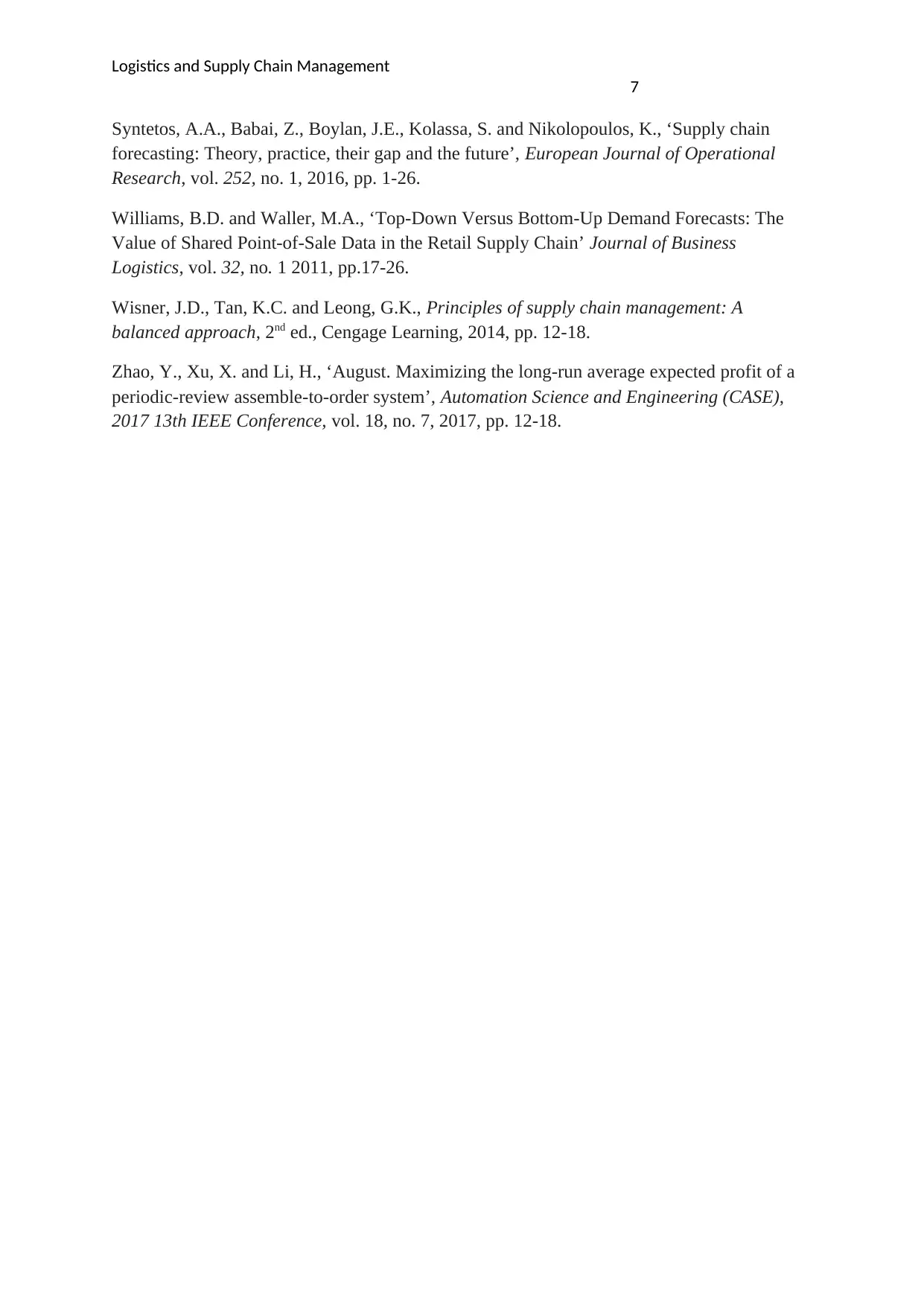
Logistics and Supply Chain Management
7
Syntetos, A.A., Babai, Z., Boylan, J.E., Kolassa, S. and Nikolopoulos, K., ‘Supply chain
forecasting: Theory, practice, their gap and the future’, European Journal of Operational
Research, vol. 252, no. 1, 2016, pp. 1-26.
Williams, B.D. and Waller, M.A., ‘Top‐Down Versus Bottom‐Up Demand Forecasts: The
Value of Shared Point‐of‐Sale Data in the Retail Supply Chain’ Journal of Business
Logistics, vol. 32, no. 1 2011, pp.17-26.
Wisner, J.D., Tan, K.C. and Leong, G.K., Principles of supply chain management: A
balanced approach, 2nd ed., Cengage Learning, 2014, pp. 12-18.
Zhao, Y., Xu, X. and Li, H., ‘August. Maximizing the long-run average expected profit of a
periodic-review assemble-to-order system’, Automation Science and Engineering (CASE),
2017 13th IEEE Conference, vol. 18, no. 7, 2017, pp. 12-18.
7
Syntetos, A.A., Babai, Z., Boylan, J.E., Kolassa, S. and Nikolopoulos, K., ‘Supply chain
forecasting: Theory, practice, their gap and the future’, European Journal of Operational
Research, vol. 252, no. 1, 2016, pp. 1-26.
Williams, B.D. and Waller, M.A., ‘Top‐Down Versus Bottom‐Up Demand Forecasts: The
Value of Shared Point‐of‐Sale Data in the Retail Supply Chain’ Journal of Business
Logistics, vol. 32, no. 1 2011, pp.17-26.
Wisner, J.D., Tan, K.C. and Leong, G.K., Principles of supply chain management: A
balanced approach, 2nd ed., Cengage Learning, 2014, pp. 12-18.
Zhao, Y., Xu, X. and Li, H., ‘August. Maximizing the long-run average expected profit of a
periodic-review assemble-to-order system’, Automation Science and Engineering (CASE),
2017 13th IEEE Conference, vol. 18, no. 7, 2017, pp. 12-18.
1 out of 8
Related Documents
Your All-in-One AI-Powered Toolkit for Academic Success.
+13062052269
info@desklib.com
Available 24*7 on WhatsApp / Email
![[object Object]](/_next/static/media/star-bottom.7253800d.svg)
Unlock your academic potential
Copyright © 2020–2025 A2Z Services. All Rights Reserved. Developed and managed by ZUCOL.





